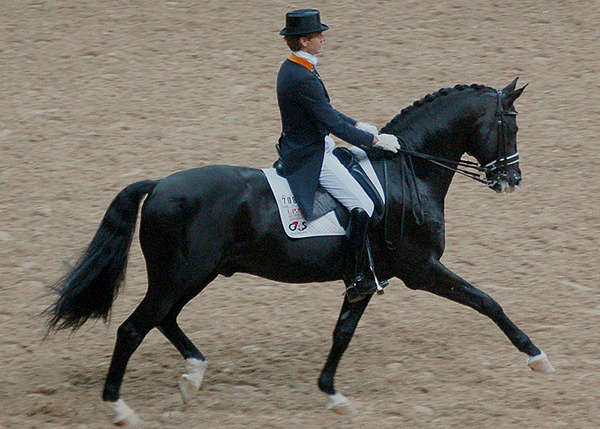
The basics of Dressage terminology F-O, there are so many we had to split them into sections.
If dressage isn’t your thing, be sure to check out more horse terminology.
Basics | English Show | Dressage A-E | Dressage F-O | Dressage P-W
Falling in / falling on inside shoulder / falling out / falling over outside shoulder
Inappropriate lateral deviation of the shoulders which involve loss of balance.
Feel the rein
Soft and giving contact in the reins.
Figure
A geometrical component of a dressage test like a circle or a figure eight.
Flexibility
The suppleness and pliability which allows joints to move freely.
Flexion
Articulation of joints such that the angle between bones is decreased.
-Longitudinal flexion – refers to the flexion of the head-neck joint.
-Lateral flexion – refers to the flexion of the second cervical joint.
Flipping
Artificial and exaggerated action of the forelegs.
Flying change
Changing the canter lead in the air during an unbroken canter stride when signaled by the rider.
Forward
Movement that is higher energy, ground covering, and lively.
Frame
The outline of the horse dictated by the relative degree of collection or extension.
Freedom
Refers to the scope, reach and elasticity in the movement of the fore and hind limbs.
Free walk
A relaxed walking pace in which the horse is given their head and allowed to stretch out their neck.
Full-pass
A sideways movement in which the horse is bent in the direction of the movement.
Gait
A walk, trot, pace, canter or gallop are all gaits.
For dressage purposes there are three gaits, walk, trot and canter.
Giving the rein
Allowing the rein to droop by pushing hands towards the horses mouth.
Goosestepping
Artificial and exaggerated action of the forelegs at the walk.
Half-halt
A momentary collection which increases the horses attention and improves its balance.
Half-pass
When a horse is moving forwards and sideways at the same time at the walk, trot or canter. The horse should be bent in the direction of the movement.
Hollow back
A depressed and sagging back caused by slackness of muscle or back muscles lacking elasticity.
Hurried / hasty / quick / rushed / rapid
Refer to quickness of tempo.
Impulsion
A thrusting release of the energy stored by engagement.
In dressage impulsion is only in the trot and canter gaits.
Inside
1. The lateral positioning of the horse
2. The side of the horse that faces the center of the ring.
Irregular
An impureness in stride, can be a momentary or pervasive and could possibly be caused by unsoundness.
*Does not mean unsteady in tempo.
Late
Delayed execution of flying changes and transitions after the aids are given.
Late behind
When the hind legs change lead after the forelegs in flying changes.
Lateral
1. Flexion, bend, suppleness or direction of movements to the side.
2. Lack of clarity at the canter.
Length bend
A uniform bend of the horses body around the inside leg of the rider.
Lift
Addresses the height the horses legs are raised while executing a piaffe or a passage.
Lightness
1. The lightness of a horse on its feet
2. The lightness in the reins
Long and low
When a horse lowers its head and stretches out its neck reaching forward and downward on a long rein.
Magpie (Magpie Hop)
Usually applied to the canter, pirouettes and flying changes when the hind feet come down at the same time.
Marching
Purposefulness of the walking steps
Manege
A rectangle or oblong area measuring 20 meters by 40 meters used for training dressage horses.
Medium
In walk, trot and canter gaits a balance between collected and extended movement.
Mobility
The nimble maneuverability of a horses shoulders, forehand and / or forelegs made possible by shortening the horses base of support.
Movement
1. The manner of a horses movement over the ground.
2. Test movement – a section of a dressage which is evaluated with a score sheet.
3. Dressage movement – leg-yielding, rein-back, shoulder-in, travers, renvers, half-pass at the trot and canter, flying changes, pirouettes, turn on the haunches, piaffe and passage.
Nodding / bobbing
An rhythmic right and left or up and down movement of a horses head and neck that is not normally part of a gaits mechanics. Can be caused by constraint or lameness.
Obedience
Willingness to follow instruction and perform movements asked by the rider.
On the aids
Responsive, alert and on the bit.
On the bit
Quiet acceptance of contact with rounded back, engaged hindquarters and arched neck.
On the forehand
When the weight of the rider and the horse are balance incorrectly on the front legs.
Outline
The sillouette and confirmation of a horse.
Outside
1. The opposite direction from which the horse should be positioned.
2. The side of the horse away from the center of the arena.
Overbent
Excessive lateral displacement of the neck in relation to the body in the neck or the base of the neck which causes a lack of uniformity in the curve of the horse.
Overflexed
Behind the vertical from excessive longitudinal flexion of the upper joints of the neck and / or poll.
Overstep / overstride / overtrack
When the hind foot steps in front of the forefoot it replaces in a stride.
Over-turned
More than 180 degrees in half-pirouette or 360 degrees in full pirouette.
Basics | English Show | Dressage A-E | Dressage F-O | Dressage P-W

Great info…I’m just starting in english riding but love to watch dressage!!!!!
Michelle
Hi Michelle,
Dressage is beautiful to watch. Too bad it is much easier to watch than it is to do! Hopefully the terminology helps.
Thank you so much this is VERY HELPFUL. I just started at a stable and they teach dressage…. so this will help me learn more. Thank you again!
Hi Leesa,
Glad you find it helpful. Good luck at the new stable and let me know if there are other things you’d like to see on the site.